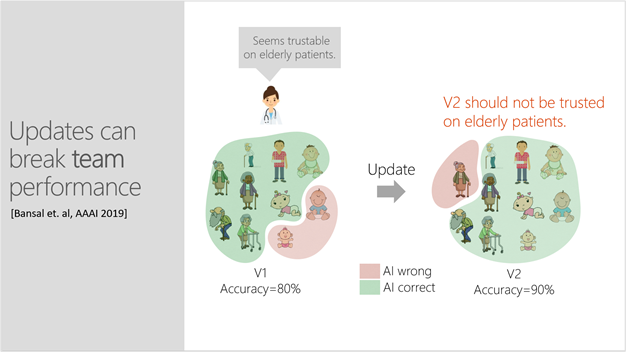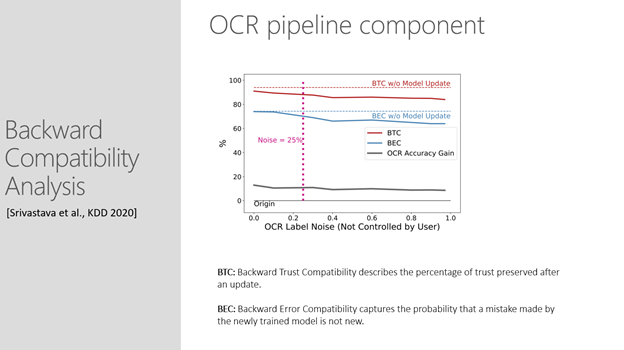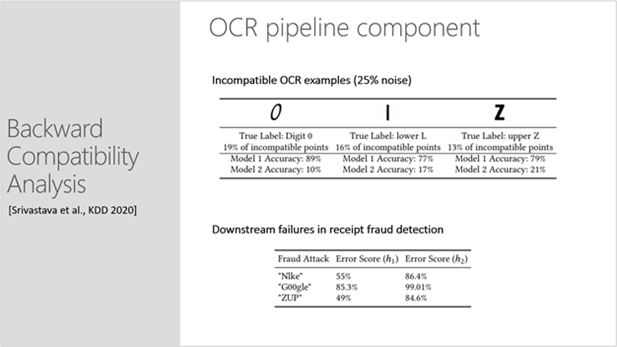Project Overview¶
Updates that may improve an AI system’s accuracy can also introduce new and unanticipated errors that damage user trust. Updates that introduce new errors can also break trust between software components and machine learning models, as these errors are propagated and compounded throughout larger integrated AI systems. The Backward Compatibility ML library is an open-source project for evaluating AI system updates in a new way for increasing system reliability and human trust in AI predictions for actions.
In this project, we define an update to an AI component to be compatible when it does not disrupt an experienced user’s insights and expectations—or mental model—of how the classifier works. An update is considered compatible only if the updated model recommends the same correct action as recommended by the previous version, which received the same input. A compatible update supports the user’s mental model and maintains trust.
Compatibility is both a usability and engineering concern. This project’s series of loss functions provides important metrics that extend beyond the single score of accuracy. These support ML practitioners in navigating performance and tradeoffs in system updates. The functions integrate easily into existing AI model-training workflows. Simple visualizations, such as Venn diagrams, further help practitioners compare models and explore performance and compatibility tradeoffs for informed choices.
Building trust in human-AI teams¶
After repeated experience with an AI system, users develop insights and expectations, a mental model, of the system’s competence. The success of human-AI partnerships is dependent on people knowing whether to trust the AI or override it. This is critically important as AI systems are used to augment human decision making in high-stakes domains such as, for example, healthcare, criminal justice, or transportation.
A problem arises when developers regularly update AI systems with improved training data or algorithms: Updates that may improve an AI’s predictive performance can also introduce new and unexpected errors that breach the end-users’ trust in the AI.
For example, a doctor uses a classifier to predict whether an elderly patient will be readmitted to the hospital shortly after being discharged. Based on the AI’s prediction and her own experience, she must decide if the patient should be placed in an outpatient program to avoid readmission. The doctor has interacted with the model quite a few times and knows that it is 80% accurate. Having learned the error boundary, she has concluded that the model is trustworthy for elderly patients. However, she is unaware that an update, which has made the model 90% accurate, now introduces errors for elderly patients and should not be trusted for this population. This puts the doctor—who is relying on an outdated mental model—at risk of making a wrong decision for her patient and will undermine her trust in the AI’s future recommendations.
Updates that may improve an AI system’s predictive performance can also introduce new and unexpected errors that breach end-users’ trust and damage the effectiveness of human-AI teams. Here, a doctor is not yet aware that an update, which increased a model’s accuracy, now introduces errors for elderly patients and should not be trusted when making decisions for this population.
Identifying unreliability problems in an update¶
It is helpful to understand that compatibility is not inbuilt, and that measuring backward compatibility can identify unreliability issues during an update. As shown in the table below, experimenting with three different datasets in high-stakes decision making (predicting recidivism, credit risk, and mortality) by updating with a larger training set only, there are cases where compatibility is as low as 40%. This means the model is now making a mistake in 60% of the cases it was getting right before the update.
Maintaining component-to-component trust¶
An incompatible update can also break trust with other software components and machine learning models that are not able to handle new errors. They instead propagate and compound these new errors throughout complex systems. Measuring backward compatibility can identify unreliability issues during an update and help ML practitioners control for backward compatibility to avoid downstream degradation.
For example, a financial services team uses an off-the-shelf OCR model to detect receipt fraud in expense reports. They have developed a heuristic blacklist component of spoofed company names (e.g., “Nlke” vs. “Nike” or “G00gle” vs. “Google”), which works well with the OCR model. Developers, with the aim of improving model performance for a wider variety of fonts, update the model with a noisy dataset of character images scraped from the internet, which people have labelled through CAPTCHA tasks. Common human annotation mistakes of confusing “l” for “i” or “0” for “o” now unexpectedly reduce the classifier’s ability to discriminate between spoofed and legitimate business names, which can lead to costly system failures.
As shown in the image below, developers can use two separate measures of backward compatibility for evaluating and avoiding downstream failures: Backward Trust Compatibility (BTC), which describes the percentage of trust preserved after an update, and Backward Error Compatibility (BEC), which captures the probability that a mistake made by the newly trained model is not new. The 89% BTC and 71% BEC scores show a decrease in backward compatibility compared with the baseline.
In this example, above, while the overall accuracy of word recognition might improve after the model update, the performance of the system on specific words in the blacklist heuristics may degrade significantly. Additionally, with backward compatibility analysis, seeing the distribution of incompatibility can be a useful guide for pinpointing where there are problems with the data.
Below illustrates how a holistic view of decreases in performance enable users to monitor incompatibility beyond examples that are explicitly impacted by noise. Here, the uppercase “Z” is often among incompatible points, even though it is not directly influenced by noise.
Components¶
The Backward Compatibility ML library has two components:
- A series of loss functions in which users can vary the weight assigned to the dissonance factor and explore performance/capability tradeoffs during machine learning optimization.
- Visualization widgets that help users examine metrics and error data in detail. They provide a view of error intersections between models and incompatibility distribution across classes.
References¶
Updates in Human-AI Teams: Understanding and Addressing the Performance/Compatibility Tradeoff. Gagan Bansal, Besmira Nushi, Ece Kamar, Daniel S Weld, Walter S Lasecki, Eric Horvitz; AAAI 2019. pdf
An Empirical Analysis of Backward Compatibility in Machine Learning Systems. Megha Srivastava, Besmira Nushi, Ece Kamar, Shital Shah, Eric Horvitz; KDD 2020. pdf
Towards Accountable AI: Hybrid Human-Machine Analyses for Characterizing System Failure. Besmira Nushi, Ece Kamar, Eric Horvitz; HCOMP 2018. pdf



